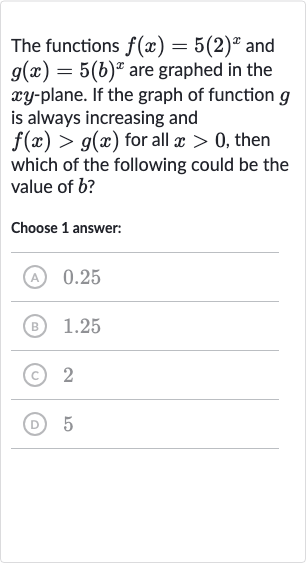Full solution
Q. The functions and are graphed in the -plane. If the graph of function is always increasing and for all , then which of the following could be the value of ?Choose answer:(A) (B) (C) (D)
- Analyze Functions: Analyze the given functions and the conditions.We have two functions and . We are told that f(x) > g(x) for all x > 0, and the graph of is always increasing. This means that must be greater than because if were less than or equal to , the graph of would not always be increasing.
- Compare Exponents: Compare the base of the exponents in and . Since is greater than for all x > 0, the base of the exponent in , which is , must be greater than the base of the exponent in , which is . Therefore, must be less than .
- Determine Possible Values: Determine the possible values of based on the given options.From the options given, we need to find a value of that is greater than (to ensure the graph of is always increasing) and less than (to ensure that f(x) > g(x) for all x > 0). Let's evaluate the options:(A) - This would not result in an increasing graph for .(B) - This is greater than and less than , so it could be a possible value for .(C) - This is equal to the base of the exponent in , so would not be greater than for all x > 0.(D) - This is greater than the base of the exponent in , so would not be greater than for all x > 0.
- Choose Correct Answer: Choose the correct answer based on the analysis.The only value that satisfies the conditions that is greater than and less than is option (B) .

